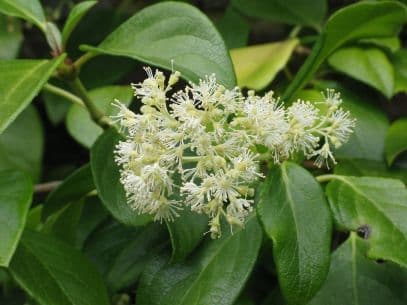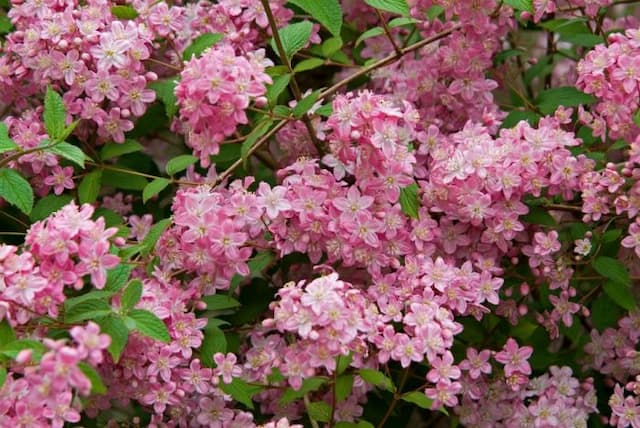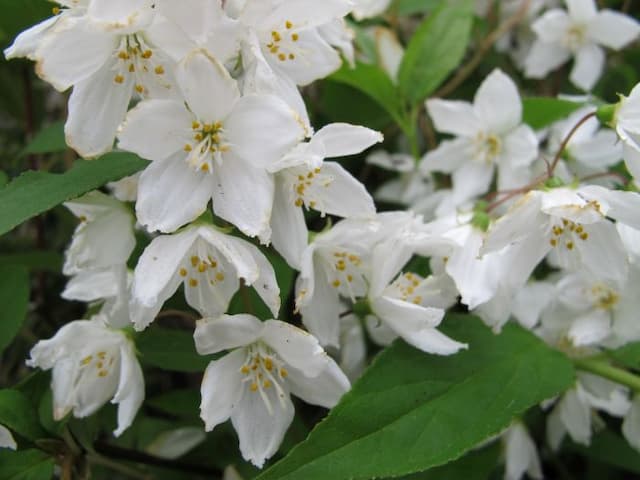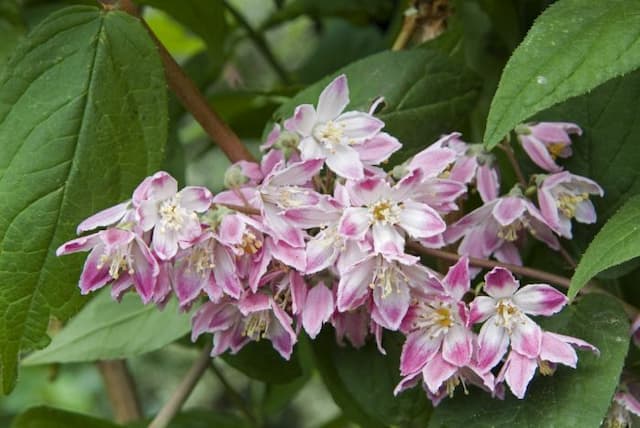Oak-leaved hydrangea Hydrangea quercifolia

ABOUT
H. quercifolia is a spreading deciduous shrub with handsome, large, deeply lobed leaves turning red and purple in autumn. Flowers cream, in conical panicles with numerous large sterile florets
About this plant
 Names
NamesFamily
Hydrangeaceae
Synonyms
Oakleaf Hydrangea, Oak-leaved Hydrangea, Oak Leaf Hydrangea
Common names
Hydrangea quercifolia
 Characteristics
CharacteristicsLife cycle
Perennials
Foliage type
Deciduous
Color of leaves
Green
Flower color
White
Height
6-8 feet (1.8-2.4 meters)
Spread
6-8 feet (1.8-2.4 meters)
Plant type
Shrub
Hardiness zones
5
Native area
Southeastern United States
Benefits
 General Benefits
General Benefits- Ornamental Value: Oakleaf hydrangea is widely appreciated for its large, showy flower clusters that bloom in summer and add aesthetic appeal to gardens.
- Seasonal Interest: Offers year-round interest with white summer flowers that fade to pink or burgundy, followed by striking fall foliage.
- Shade Tolerance: It is well-suited for planting in shady areas where many other plants do not thrive.
- Drought Resistance: Once established, oakleaf hydrangea can tolerate periods of drought, making it suitable for xeriscaping and low-water gardens.
- Erosion Control: The extensive root system helps to stabilize soil and control erosion on slopes or in areas where runoff is a problem.
- Wildlife Attraction: Attracts pollinators such as butterflies and bees during its blooming period and provides habitat for birds.
- Low Maintenance: Requires minimal pruning and is less susceptible to pests and diseases compared to some other garden plants.
- Versatility: Can be used for a variety of garden designs, including borders, hedges, or as a standout specimen plant.
 Medical Properties
Medical PropertiesThis plant is not used for medical purposes.
 Air-purifying Qualities
Air-purifying QualitiesThis plant is not specifically known for air purifying qualities.
 Other Uses
Other Uses- Hydrangea quercifolia, commonly known as the oakleaf hydrangea, can be used for dyeing fabric with the roots yielding a natural rusty-brown color.
- The large leaves of the oakleaf hydrangea can be used to create leaf castings, decorative art pieces that capture intricate leaf details in cement or plaster.
- Due to its striking autumn foliage, branches with dried leaves can be integrated into floral displays and wreaths for home decoration purposes.
- The wood of the oakleaf hydrangea, though not commonly used, can serve as a crafting material for creating small wooden objects or tools when properly dried and treated.
- Dried hydrangea blooms make for a sustainable packing material alternative for shipping fragile items, as they can be both soft and cushioning.
- In landscaping, the oakleaf hydrangea’s durable roots help stabilize soil and prevent erosion on slopes or in areas prone to washing out.
- The bark of the oakleaf hydrangea can be incorporated into mulch mixes, providing a natural way to suppress weeds and retain soil moisture in gardens.
- During fall, the oakleaf hydrangea's leaves can be collected and used as natural mulch providing not only soil nutrients but also an appealing aesthetic touch to garden beds.
- Captured rainwater dripping off the broad leaves of Hydrangea quercifolia can be funneled into rain gardens, supporting water-conservation efforts.
- Photographers and painters often use the impressive blooms and foliage of the oakleaf hydrangea as a subject or background for their botanical-themed art works.
Interesting Facts
 Feng Shui
Feng ShuiThe Oakleaf Hydrangea is not used in Feng Shui practice.
 Zodiac Sign Compitability
Zodiac Sign CompitabilityThe Oakleaf Hydrangea is not used in astrology practice.
 Plant Symbolism
Plant Symbolism- Heartfelt Emotions: Hydrangea quercifolia, commonly known as Oakleaf Hydrangea, often symbolizes deep, heartfelt emotions due to its lush and abundant blooms.
- Gratitude: Oakleaf Hydrangea is associated with thankfulness, commonly given as gifts to express appreciation.
- Understanding: The delicate, interlocking nature of its flowers can represent comprehension and mutual understanding in relationships.
- Abundance: The voluminous flowers of the Oakleaf Hydrangea embody the idea of abundance, whether it be of love, prosperity, or opportunities.
- Beauty: With its striking flowers and bold leaves, this plant embodies the notion of beauty and grace.
- Fragility: The fleeting nature of its blossoms can symbolize the ephemeral and delicate aspects of life and experiences.
- Vanity: In some cultures, the Oakleaf Hydrangea is a symbol of vanity or boastfulness due to its showy display.
 Water
WaterOakleaf hydrangeas should be watered deeply once a week, ensuring the soil is moist but not waterlogged. During hot or dry weather, increase the frequency to twice per week, providing about 1 to 1.5 gallons of water each time to sustain the plant. It's important to avoid overhead watering to prevent leaf diseases; instead, water at the base of the plant, directing the moisture to the root zone. Reduce watering in the fall as the plant prepares for dormancy, and during winter, only water if the soil is very dry.
 Light
LightOakleaf hydrangeas thrive best in partial shade, preferring a spot that receives morning sunlight and afternoon shade to protect it from the intense heat of the day. They can tolerate full sun in cooler climates, but in hotter areas, they must be shielded during the peak sun hours to prevent leaf scorch.
 Temperature
TemperatureOakleaf hydrangeas are hardy from USDA zone 5 to 9, withstanding minimum temperatures of -20°F and maximum temperatures of around 90°F. The ideal temperature range for oakleaf hydrangeas is between 50°F and 80°F. They are resilient to temperature fluctuations within this range but require protection from late spring frosts which can damage new growth.
 Pruning
PruningPrune oakleaf hydrangeas immediately after they finish blooming in summer, as they bloom on old wood. Pruning encourages healthy growth and prevents the shrub from becoming too large. Cut away dead or crossing branches to improve air circulation and shape the plant, but avoid heavy pruning, as this can reduce the number of flowers in the following season.
 Cleaning
CleaningAs needed
 Soil
SoilFor Oakleaf Hydrangea, the best soil mix is well-draining, rich in organic matter, and slightly acidic with pH 5.5 to 6.5. A blend of loamy soil, peat moss, and decomposed pine bark can provide the necessary conditions for healthy growth.
 Repotting
RepottingOakleaf Hydrangeas typically don't require frequent repotting and can be repotted every 3 to 5 years as they prefer being root-bound to prompt flowering.
 Humidity & Misting
Humidity & MistingOakleaf Hydrangeas prefer moderate humidity levels; however, they are adaptable and can tolerate the humidity levels typically found in temperate outdoor environments.
 Suitable locations
Suitable locationsIndoor
Keep Oakleaf Hydrangea in a bright spot, ensure high humidity.
Outdoor
Plant in partial shade; mulch well; keep soil moist.
Hardiness zone
5-9 USDA
 Life cycle
Life cycleOakleaf hydrangea (Hydrangea quercifolia) begins its life cycle with seed germination, which typically occurs in damp, well-drained soil in partial to full shade. Seedlings develop into juvenile plants, growing leaves shaped like those of an oak tree, from which the plant derives its common name. As the oakleaf hydrangea matures, it forms a woody structure with multiple stems and can reach 6 to 8 feet tall. The plant flowers in early summer, producing cone-shaped clusters of white blooms that gradually turn to pinkish-purple as they age. After the flowering stage, the plant sets seed, which can be dispersed by wind or wildlife, beginning the cycle anew. During fall, the leaves of the oakleaf hydrangea change to vibrant shades of red, bronze, and purple, and in winter, the plant goes dormant, awaiting spring to start its growth cycle again.
 Propogation
PropogationPropogation time
Late summer
The Oakleaf Hydrangea (Hydrangea quercifolia) is most commonly propagated through stem cuttings. The ideal time for taking cuttings is in early summer when the plant's new growth is still tender and flexible, often termed as being in the "softwood" stage. For propagation, gardeners typically cut a piece of stem about 4 to 6 inches (10 to 15 centimeters) long, making sure it has several pairs of leaves. The bottom set of leaves is removed, and the cut end of the stem is then dipped in rooting hormone to encourage root development. This treated cutting is planted in a moist potting mix, ensuring that the nodes where the leaves were removed are buried in the soil, as this is where the roots will emerge. The pot should then be placed in a warm, bright location out of direct sunlight, and the soil should be kept consistently moist. In this supportive environment, the cutting will develop roots over several weeks, after which it can be transplanted into the garden.






![Rose deutzia [Yuki Cherry Blossom]](/_next/image?url=https%3A%2F%2Fplants-admin.emdemapps.com%2Fimages%2Fplants%2F%2Fimages%2F604b6510a383a.png&w=640&q=75)

![Hydrangea [Hot Chocolate]](/_next/image?url=https%3A%2F%2Fplants-admin.emdemapps.com%2Fimages%2Fplants%2F%2Fimages%2F604b5a066e3bd.png&w=640&q=75)
![Hydrangea [Blackberry Pie]](/_next/image?url=https%3A%2F%2Fplants-admin.emdemapps.com%2Fimages%2Fplants%2F%2Fimages%2F604b56e2abc1d.png&w=640&q=75)